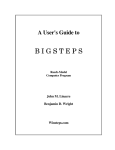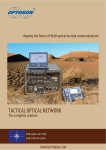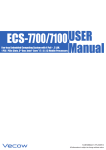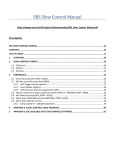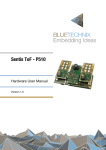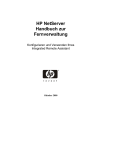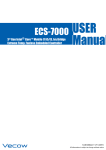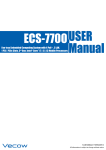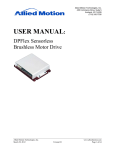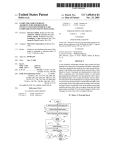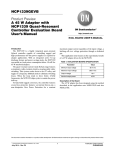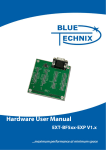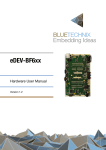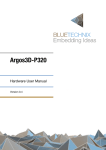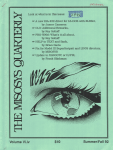Download Hardware User Manual
Transcript
ToF-Flash Hardware User Manual Version 3.1 Contact Bluetechnix Waidhausenstraße 3/19 A-1140 Vienna AUSTRIA office@bluetechnix.com http://www.bluetechnix.com Document No.: 100-1221-3 Date: 2014-10-02 © Bluetechnix 2014 Table of Contents 1 2 Introduction ....................................................................................................................................... 6 1.1 Overview .................................................................................................................................... 6 1.2 Key Features .............................................................................................................................. 6 System Architecture.......................................................................................................................... 7 2.1 Components .............................................................................................................................. 7 2.1.1 Power Supply ..................................................................................................................... 7 2.1.2 LVDS Clock Distributor....................................................................................................... 7 2.1.3 LIM ...................................................................................................................................... 7 2.2 Interfaces ................................................................................................................................... 7 2.2.1 Power Connector................................................................................................................ 7 2.2.2 Mod Light Connector ......................................................................................................... 8 2.3 LIM Addressing .......................................................................................................................... 8 2.4 Application Range...................................................................................................................... 9 2.4.1 IR-LED ................................................................................................................................ 9 2.4.2 Temperature Range ............................................................................................................ 9 2.5 Electrical Specifications ........................................................................................................... 10 2.5.1 Operating Conditions ....................................................................................................... 10 2.5.2 Absolute Maximum Ratings ............................................................................................. 10 2.5.3 Input current ..................................................................................................................... 11 2.5.4 Electrical Power Considerations ...................................................................................... 11 2.6 Mechanical Requirements ....................................................................................................... 12 2.6.1 Outline .............................................................................................................................. 12 2.6.2 LED Placement ................................................................................................................. 12 2.6.3 Cooling ............................................................................................................................. 13 2.6.4 Gap Pad ............................................................................................................................ 14 2.6.5 Mounting ........................................................................................................................... 14 2.6.6 ToF-Flash Adapter ............................................................................................................ 14 2.6.7 Cooling Plate .................................................................................................................... 14 2.7 Environmental requirements .................................................................................................... 15 2.7.1 Temperature ..................................................................................................................... 15 2.7.2 Humidity............................................................................................................................ 15 2.7.3 G-force, vibration.............................................................................................................. 15 2.8 EMC and safety requirements ................................................................................................. 15 3 Document Revision History ............................................................................................................ 16 A List of Figures and Tables ............................................................................................................... 17 © Bluetechnix 2014 © Bluetechnix 2014 © Bluetechnix 2014 All Rights Reserved. The information herein is given to describe certain components and shall not be considered as a guarantee of characteristics. Terms of delivery and rights of technical change reserved. We hereby disclaim any warranties, including but not limited to warranties of non-infringement, regarding circuits, descriptions and charts stated herein. Bluetechnix makes and you receive no warranties or conditions, express, implied, statutory or in any communication with you. Bluetechnix specifically disclaims any implied warranty of merchantability or fitness for a particular purpose. Bluetechnix takes no liability for any damages and errors causing of the usage of this board. The user of this board is responsible by himself for the functionality of his application. He is allowed to use the board only if he has the qualification. More information is found in the General Terms and Conditions (AGB). Information For further information on technology, delivery terms and conditions and prices please contact Bluetechnix (http://www.bluetechnix.com). Warning Due to technical requirements components may contain dangerous substances. © Bluetechnix 2014 Hardware Use Manual - ToF-Flash 1 Last change: 2 October 2014 Version 3.1 Introduction 1.1 Overview The ToF-Flash is an external high-power IR-flash module for ToF depth sensors like the Argos-3D-P100, or the Sentis-ToF-M100. The ToF-Flash is powered over a standard 2 pole terminal connector and receives a synchronization signal via a 4 pole Interface connector. 1.2 Key Features - Light enhancement for all Bluetechnix ToF camera Products. - Optical Output Power: 10W - Opening angle: 100° - Plastic lenses for different opening angles available © Bluetechnix 2014 Page 6 | 17 Hardware Use Manual - ToF-Flash 2 Last change: 2 October 2014 Version 3.1 System Architecture ToF-Flash 3.3V Supply LIM1 3D-Scene LVDS Distributor Protection Circuit Vin LIM2 LVDS OWI Figure 2-1: Hardware Architecture 2.1 2.1.1 Components Power Supply The input-voltage is variable from 12V to 30V. The circuit is protected against load transients and reverse polarity. 2.1.2 LVDS Clock Distributor To maintain a good signal quality, the SY89832U LVDS clock distributor splits up the single input signal to two modulation signals for each LIM. 2.1.3 LIM Two LIM-U-LED-850 modules can be connected to the ToF-Flasher V3. 2.2 2.2.1 Interfaces Power Connector A two pole terminal connector allows powering the Hardware. The used part is a 691322110002 from Würth Electronic. The mating screw-terminal connector is 691361100002. Pin 1 2 Name VIN GND Description Positive Power Supply Power Ground Table 2-1: Power Connector Description © Bluetechnix 2014 Page 7 | 17 Hardware Use Manual - ToF-Flash Last change: 2 October 2014 Version 3.1 Pin 1 Pin 1 Figure 2-2: ToF-Flash Connectors 2.2.2 Mod Light Connector The Argos-P100 LED Mod Light Interface delivers the LVDS modulation signal and has an additional one wire interface pin (OWI) which is connected to both oft the OWI interfaces of the LIM modules. This signal pin accepts 3.3V TTL voltage levels. The used connector is a MQ172X-4PA from Hirose; the mating part is MQ172X-4SA-CV, available at mouser or Digy-Key. Pin 1 2 3 4 Name OWI MOD_N MOD_P GND Description One wire interface Inverting LVDS input of the modulation signal Non-inverting LVDS input of the modulation signal Signal ground Table 2-2: Modulation Connector Interface Description Pin 1 Figure 2-3: Mod Light Interface In addition to the Mod Light connector a standard USB-B plug can be optionally mounted on the bottom side of the ToF-Flash adapter. This plug is by default not mounted. Pin 1 2 3 4 5 Name NC MOD_N MOD_P OWI GND Description Signal ground Inverting LVDS input of the modulation signal Non-inverting LVDS input of the modulation signal One wire interface Table 2-3: Auxiliary Modulation Connector Interface Description 2.3 LIM Addressing The OWI is routed to both LIM modules. To have access to both, the SADDR0 addressing pin is set different for each module (high for the left module, low for the right). To be able to access even more ToFFlashers, the address of each ToF-Flasher can be set with the bottom mounted DIP-Switch. Eight different addresses are possible. See the following table for detailed settings. © Bluetechnix 2014 Page 8 | 17 Hardware Use Manual - ToF-Flash Switch Setting 1) [87654321] 0000000x 0000001x 0000010x 0000100x 0001000x 0010000x 0100000x 1000000x Last change: 2 October 2014 Version 3.1 Left LIM Address 0x01 0x03 0x05 0x07 0x09 0x0B 0x0D 0x0F Right LIM Address 0x02 0x04 0x06 0x08 0x0A 0x0C 0x0E 0x10 Table 2-4 Serial Interface Address Configuration NOTE 1): 0 means that the switch is OFF, 1 that it is ON. The switch number 1 has no functionality Pin 1 Switch 8 Switch 1 Figure 2-4: Serial Address Setting 2.4 2.4.1 Application Range IR-LED The twelve LEDs (six for each LIM) are sufficient for a view range of approximately 10m (strong dependent on the reflectivity of the target) with a viewing angle of 90°. 2.4.2 Temperature Range Recommended operating temperature: -40°C to +55C°. Maximum ambient temperature: -40°C to +85C°. The maximum operating temperature is strongly dependent on the application. If only short integration times (lower range) and low frame-rates are needed, or a high sophisticated cooling system is applied, higher ambient temperatures are possible. High ambient temperatures (up to 85°C) cause no damage to the device, but the ToF system won’t work because the over-heat protection turns off the LEDs for protection and increased LED lifetime. © Bluetechnix 2014 Page 9 | 17 Hardware Use Manual - ToF-Flash 2.5 2.5.1 Last change: 2 October 2014 Version 3.1 Electrical Specifications Operating Conditions Symbol VIN PLED VCC IIN VOH VOL VIH VIL IO TOP φAMB FITP3) Parameter LED supply voltage Power consumption during ToF integration 1) Logic supply voltage Supply current High level output voltage Low level output voltage High level input voltage Low level input voltage Output current on IO pin Operating temperature on PCB Relative ambient humidity (non-condensing) Frame-rate integration time product Min 12 Typical 12/24 3.0 3.3 2.8 0 2.31 -100 -40 10 Max 30 61.5 3.6 4.172) 3.3 0.5 1.15 100 85 90 10 Unit V W V A V V V V mA °C % Table 2.5: Electrical characteristics Note 1) Average power for a ToF modulation signal with 50% duty cycle with 6 LEDs mounted on each LIM. Note 2) Limited by the on-board protection circuit. Note 3) The Frame-rate Integration time product indicates the power consumption based on integration time in milliseconds and frame-rate (FITP = 4 * ti * fr). The maximum value is valid without cooling. Warning Do not operate this device without appropriate cooling! An operation without appropriate cooling may cause permanent damage to the device. 2.5.2 Absolute Maximum Ratings Stressing the device above the rating listed in the absolute maximum ratings table may cause permanent damage to the device. These are stress ratings only. Operation of the device at these or any other conditions greater than those indicated in the operating sections of this specification is not implied. Exposure to absolute maximum rating conditions for extended periods may affect device reliability. Symbol VIN VIO TAMB TSTO φAMB Parameter LED supply voltage Input or output voltage Ambient temperature Storage temperature Relative ambient humidity (non-condensing) Min -30 -0.3 -40 -55 0 Max 30 3.6 85 125 90 Unit V V °C °C % Table 2.6: Absolute maximum ratings © Bluetechnix 2014 Page 10 | 17 Hardware Use Manual - ToF-Flash 2.5.3 Last change: 2 October 2014 Version 3.1 Input current The input current depends on the selected frame-rate (fps) and the integration time (tINT). The following figure shows typical values. The values for the x axis shows the FITP which has been calculated with the following equation: 1 𝐹𝐹𝐼𝐼𝐼𝐼𝐼𝐼 = 𝑡𝑡𝐼𝐼𝐼𝐼𝐼𝐼 [𝑚𝑚𝑚𝑚] ∙ 𝑓𝑓𝑓𝑓𝑓𝑓 � � ∙ 4 𝑠𝑠 60 y = 0.0378x + 22.104 Input Power (W) 50 y = 0.0274x + 15.632 40 30 P @ 24V Vin Linear Zone P @ 12V Linear Zone 20 10 0 0 200 400 600 800 frame-rate integration time product 1000 Figure 2-5: Input power depending on frame-rate integration time product 2.5.4 Electrical Power Considerations The supply voltage range is 12V to 30V, the maximum input power can be assumed as 60W. The maximum input current is ca. 5A @ 12V input voltage. The current protection as well as the over and under voltage protection is realized with LT4356. Part LVDS Splitter LIM @ 3.3V Sum: Current 75 mA 2x 50 mA 175 mA Power 248 mW 330 mW 578 mW Table 2-7: 3.3V Domain Power Estimation Part LIM 1 LIM 2 FAN Curent 3 x 1.2A 3 x 1.2A 0.1A Sum: Power 30 W 30 W 1W 61 W peak power Table 2-8: 11V Domain Power Estimation A peak power consumption of approximately 61.5 W is expected. © Bluetechnix 2014 Page 11 | 17 Hardware Use Manual - ToF-Flash 2.6 2.6.1 Last change: 2 October 2014 Version 3.1 Mechanical Requirements Outline 80 x 80 mm. The total height mainly depends on the cooling. It can be also up to 80mm. 2.6.2 LED Placement Half Angle Barrier If the ToF-Flash Module will be embedded into an enclosure, care must be taken to not shadow the light cone of the LEDs. The following drawing shows the calculation model. α/2 LED Figure 2-6: LED distance to barrier calculation model The light cone origin is located 2mm above the PCB surface. For the exact LED position can be taken from the LIM specification. The two LIMs are located right next to each other. Figure 2-7: LED placement on the LIM module © Bluetechnix 2014 Page 12 | 17 Hardware Use Manual - ToF-Flash 2.6.3 Last change: 2 October 2014 Version 3.1 Cooling Calculation considerations: • • • The LEDs have an efficiency of at least 21%, i.e. the thermal power can be calculated as follows: PLED = IRMS * Vf * 0.79 = 1.2A * 3.2V *0.79 = 3W Only the most power consuming parts are taken in consideration. Compare to this parts, the rest can be neglected. This Parts are: o 12 LEDs (3W each) o 4 LED series resistors (0.98W each) o 4 half bridge FETs (0.4W each) o 2 Buck Converter (including all Parts: 2.2W) The worst-case relation between integration-time and read-out-time is 93% (achievable with an integration time of 20ms). The following drawing shows the used model for temperature calculations. Figure 2-8: Thermal Power Calculation Model Following heat spreaders fit to the design: Name 517-95AB 241214B91200G 241204B92200G RT [K/W @ lfm] 2 @ 300 1 @ 200 3 @ 300 Lxbxh Hersteller 61 x 58 x 24 61 x 58 x 36 61 x 58 x 36 WAKEFIELD SOLUTIONS AAVID THERMALLOY AAVID THERMALLOY Bestellnummer (Disti) 1838853 (Farnell) 1436803 (Farnell) 1703176 (Farnell) Preis 4.8 9.2 5.2 Table 2-9: Applicable Heat Spreader Following Cooling Fans could be used: MB60251V2-0000-A99 (25mm), MB60201V2-0000-A99 (20mm). This fan complies following certifications and safety guidance: Figure 2-9: fan certification and safety © Bluetechnix 2014 Page 13 | 17 Hardware Use Manual - ToF-Flash 2.6.4 Last change: 2 October 2014 Version 3.1 Gap Pad Berquist Gap Pad 2500S20. 2.6.5 Mounting The ToF-Flash module is itself a modular system. The fixed parts are the ToF-.Flash adapter, and the two LIM-U-LED-850 modules. Other parts (mainly for cooling) may alter for different application. 2.6.6 ToF-Flash Adapter This chapter describes the ToF-Flash adapter dimensions, for the LIM dimensions refer to the LIM-U-LED850 Hardware User Manual. Figure 2-10: Adapter PCB Top Dimensions Figure 2-11: Adapter PCB Bottom Side Dimensions 2.6.7 Cooling Plate For a stand-alone variant of the ToF-Flasher, a cooling plate is needed for assembling the two LIMs to the heat spreader. © Bluetechnix 2014 Page 14 | 17 Hardware Use Manual - ToF-Flash Last change: 2 October 2014 Version 3.1 Figure 2-12: Cooling Plate Dimensions 2.7 2.7.1 Environmental requirements Temperature -20°C to +55°C. 2.7.2 Humidity 10% to 90% non-condensing. 2.7.3 G-force, vibration The ToF-Flasher module is designed for stationary operation. For rough environments, additional measurements must be ordered. 2.8 EMC and safety requirements The product should fulfill all requirements for CE conformity declaration as specified in 2004/108/EG. EMV: EN55022, Class A; EN55024 Eye Safety: EN 62471 © Bluetechnix 2014 Page 15 | 17 Hardware Use Manual - ToF-Flash 3 Last change: 2 October 2014 Version 3.1 Document Revision History Version 1 2 3 Date 2014 07 23 2014 07 25 2014 10 02 Author DST MHO DST Description Adaptions for Hardware Revision V2.0 Added FITP vs. Power diagram Adaptions for Hardware Revision V3.0 Table 3-1: Revision history © Bluetechnix 2014 Page 16 | 17 Hardware Use Manual - ToF-Flash A List of Figures and Tables Last change: 2 October 2014 Version 3.1 Figures Figure 2-1: Hardware Architecture ................................................................................................................... 7 Figure 2-2: ToF-Flash Connectors ................................................................................................................... 8 Figure 2-3: Mod Light Interface ........................................................................................................................ 8 Figure 2-4: Serial Address Setting ................................................................................................................... 9 Figure 2-5: Input power depending on frame-rate integration time product ................................................. 11 Figure 2-6: LED distance to barrier calculation model ................................................................................... 12 Figure 2-7: LED placement on the LIM module ............................................................................................. 12 Figure 2-8: Thermal Power Calculation Model ............................................................................................... 13 Figure 2-9: fan certification and safety ........................................................................................................... 13 Figure 2-10: Adapter PCB Top Dimensions ................................................................................................... 14 Figure 2-11: Adapter PCB Bottom Side Dimensions ..................................................................................... 14 Figure 2-12: Cooling Plate Dimensions .......................................................................................................... 15 Tables Table 2-1: Power Connector Description ......................................................................................................... 7 Table 2-2: Modulation Connector Interface Description .................................................................................. 8 Table 2-3: Auxiliary Modulation Connector Interface Description ................................................................... 8 Table 2-4 Serial Interface Address Configuration ............................................................................................ 9 Table 2.5: Electrical characteristics ................................................................................................................ 10 Table 2.6: Absolute maximum ratings ............................................................................................................ 10 Table 2-7: 3.3V Domain Power Estimation .................................................................................................... 11 Table 2-8: 11V Domain Power Estimation ..................................................................................................... 11 Table 2-9: Applicable Heat Spreader ............................................................................................................. 13 Table 3-1: Revision history ............................................................................................................................. 16 © Bluetechnix 2014 Page 17 | 17

















